At cinch, I was tasked with re-baselining how cinch fulfils it's orders, with all business areas involved in delivering the service, in order to gain a shared understanding and drive improvement.

Photo by Fabio Henning on Unsplash
Upon launch the online car supermarket, cinch, had rapidly delivered a service to get cars customers had ordered online delivered to them successfully. This part of the service had not been revisited since launch and there was a lack of understanding of how the service was performing.
By revisiting the service, the aim was to identify where pain existed or had built up since the business launched and identify where opportunities were to provide the best experience for our customers. The aim was also to identify opportunities to improve operational efficiencies to provide better business outcomes. Those opportunities discovered would then form roadmap items (to teams involved in delivering the service) to drive change and improvement of the service.
Discovery
To start to understand the service, I began by mapping the customer journey from placing an order to getting their car delivered. To build on this, I collaborated with the cinch product team to map all the events, systems and processes involved from a technical perspective. A large part of the service involved many different areas of the business, many of which sat outside the product teams. Therefore, I set up a collaborative mapping session with all teams involved, including the team who prepare the cars, the teams who move the cars around the country, the teams who deliver the cars to customers and the customer service team who support customers across the whole journey. In the session, we ran through the map I had already created and got the teams to validate the people, processes and systems involved at each stage.
Whilst mapping out the stages, we also encouraged teams to talk through pain points they were experiencing in trying to deliver the service. This helped with shared understanding across different business areas and fostered opportunities to collaborate further on solving problems.
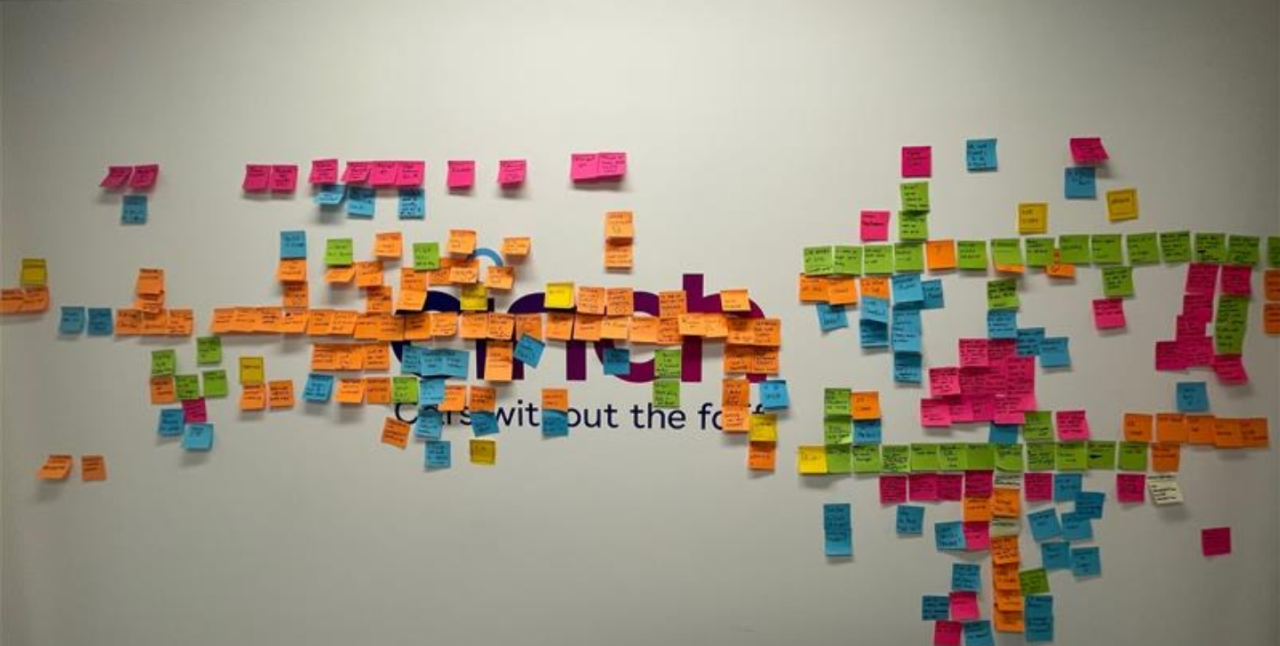
Photo of initial mapping workshop
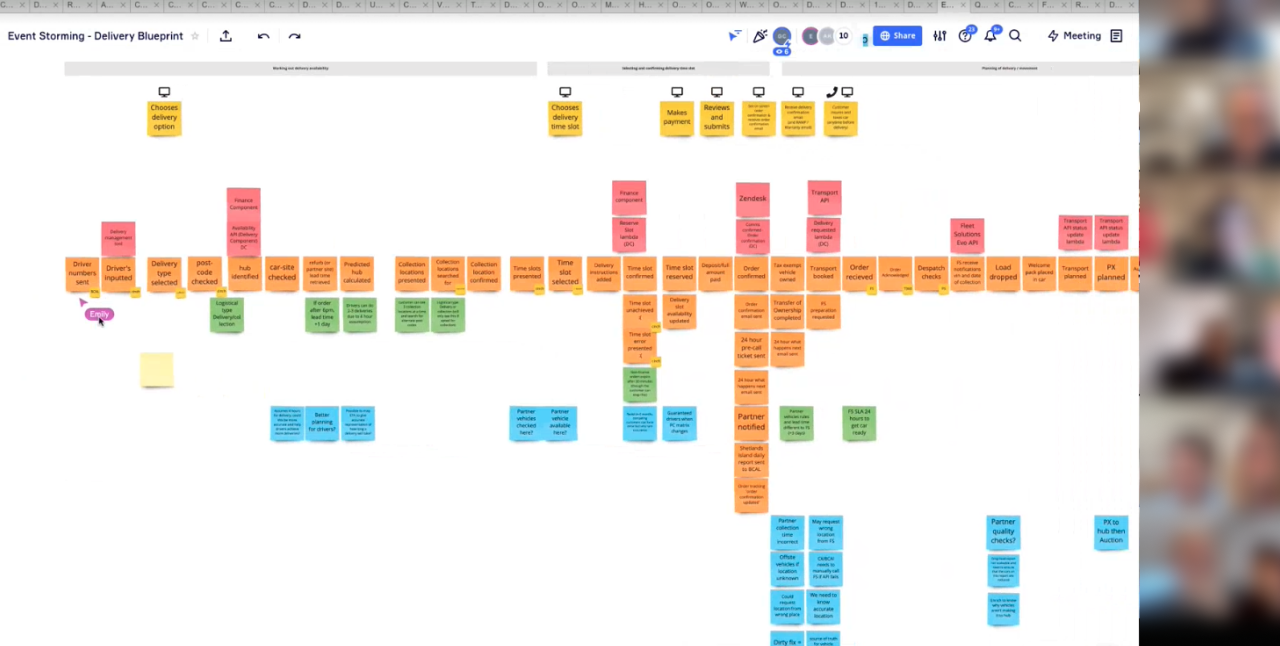
Online collaborative mapping workshop
Developing the service blueprint
After the mapping workshops, I started to go through all the insights, notes and pain points documented and began to build out the service blueprint. By starting to build out the full service with each teams process build across separate swim-lanes, I could start to link up interactions from one team to another. This also enabled me to see gaps and missing connections that we needed to fill. Therefore, I set up and ran mini workshops with specific teams to dig deeper into those areas.

Notes gathered from all the collaborative workshops
Once I had all steps mapped, I could overlay all the pain points across the service, from both the customers and business. For customer pain points, I used insights from user research and post delivery surveys. Through analysis of feedback, I began to group themes of common issues customers were experiencing from completing their order to getting their car delivered.
For business pain points, I used insights gained from the collaborative mapping workshop. I also used insight from observational research conducted at various locations across the business, including visits to prep centres and hubs where cars are prepared for delivery, plus driving along with drivers who were delivering cars to real customers. Similarly to the customer insights, I grouped themes of common issues.
To help communicate where the pain points existed in the service, I decided to add red dots in the top right hand corners of steps, with the number of pain points associated with that specific step. Underneath the map, I broke down each point point and linked it to the step. This meant that at a glance, we could see where pain manifested across the whole service and then go deeper into detail to understand what the pain actually was.
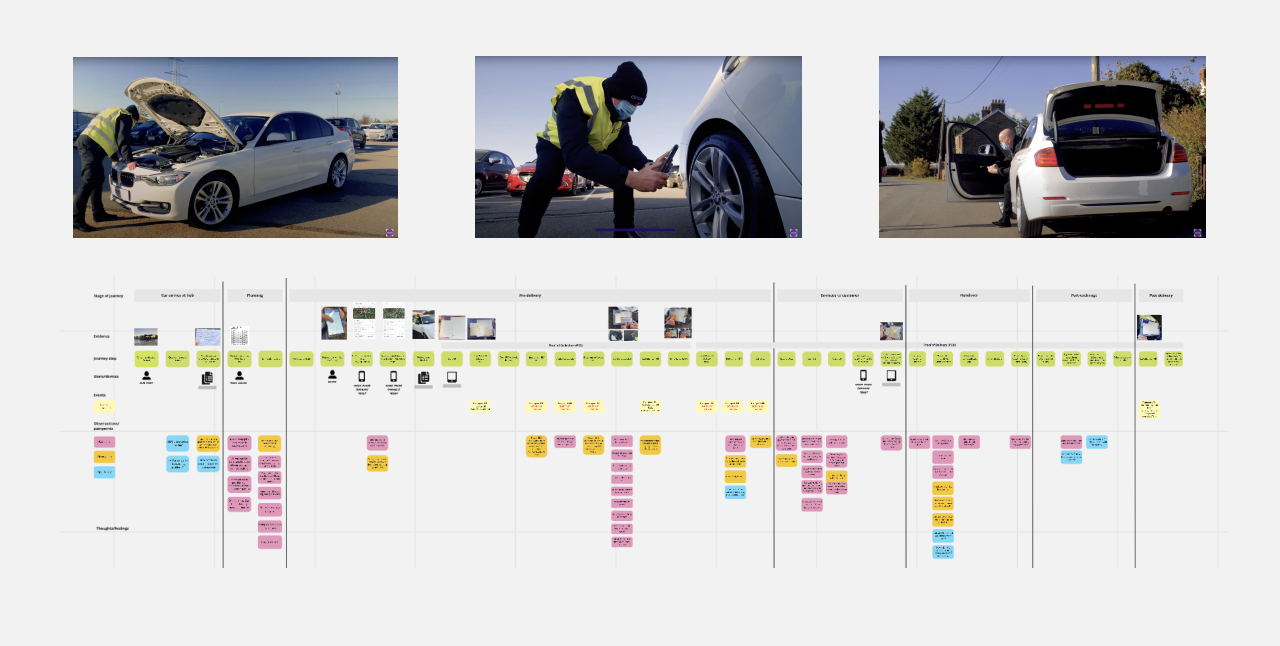
Insights from an observation session

Insights from the customer post delivery survey
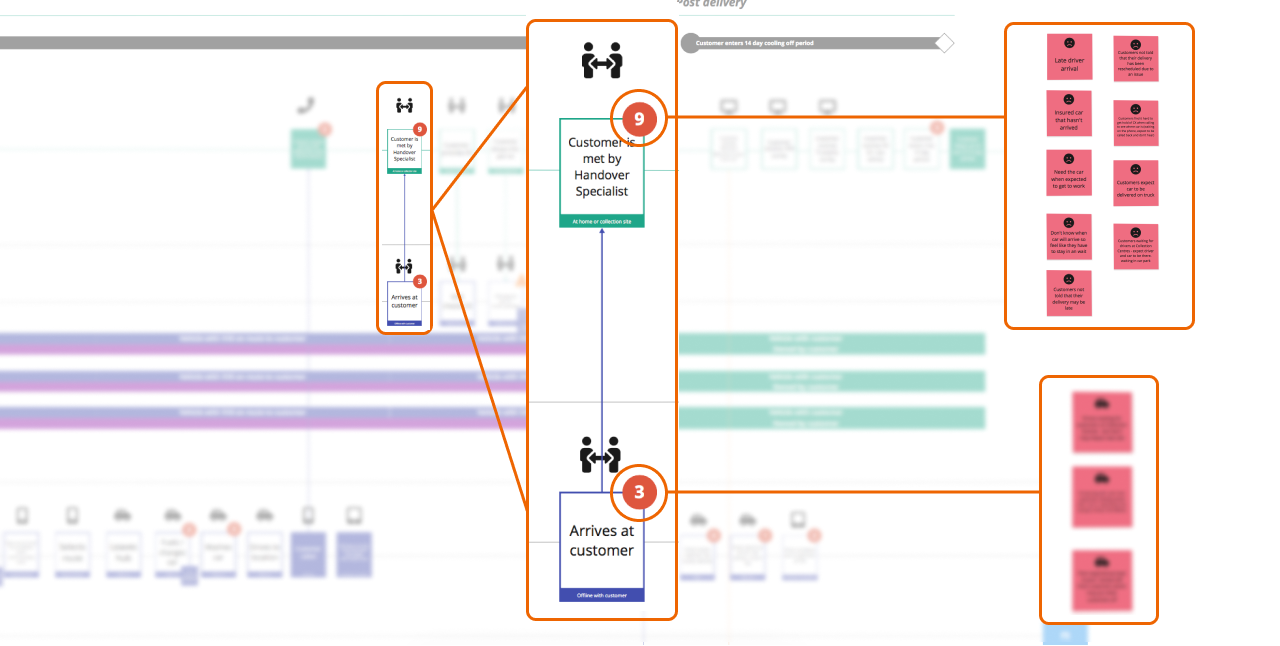
Highlighting customer and business pain points across the service
Defining the problems
Using the service blueprint, I began analysis to define the problem areas across the service. To do this, I started with looking at all the pain across the customer journey and used the blueprint to identify route causes of those issues.
For example, I observed that customers were calling the cinch customer service team on the day of delivery to chase where their delivery was as their time slot for delivery had been missed. From the service blueprint, I could see that cinch delivery drivers would switch jobs last minute, would spend lots of time checking over the car before delivery and spend time and effort fuelling and cleaning cars. I had also learnt that part exchanges were un-drivable, meaning that delivery drivers had no way to get back to the hub for their next delivery. All of these issues in process contributed to deliveries being late to customers. This highlighted a huge opportunity to look at the delivery drivers process to streamline and ensure time to complete various tasks is considered to ensure all deliveries are on time.
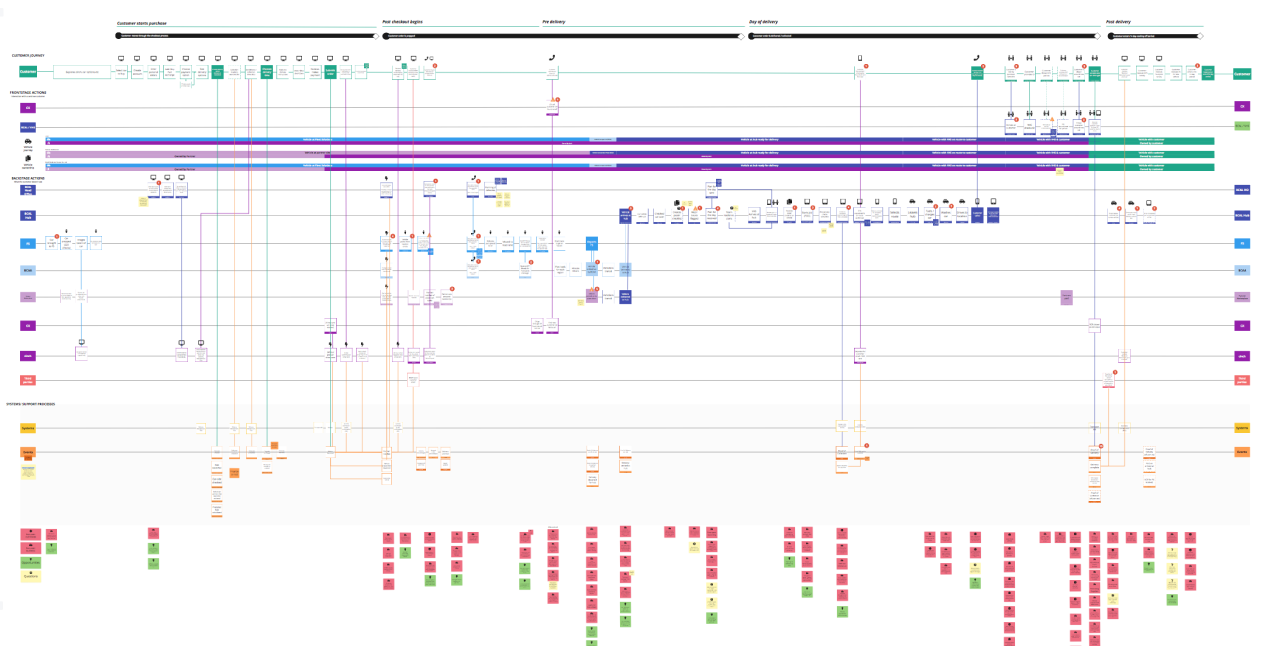
The full end to end service blueprint
In some cases, the delivery was late as there was an issue with the car or with the finance being ready which meant the delivery was aborted. However, customers were not told about this and therefore expected the delivery to be as expected. From digging into the service blueprint, I could see that any issue with a vehicle would be communicated between the prep centres, delivery hubs and transportation teams but not directly with cinch. This led to customer service teams being out of the loop and unaware that they need to inform customers.
To make sure I had uncovered all issues and identified route causes across the service, I collected all the pain points and generated an affinity map of themes. I then highlighted the business areas involved to indicate who we would need to collaborate with in order to drive improvements.
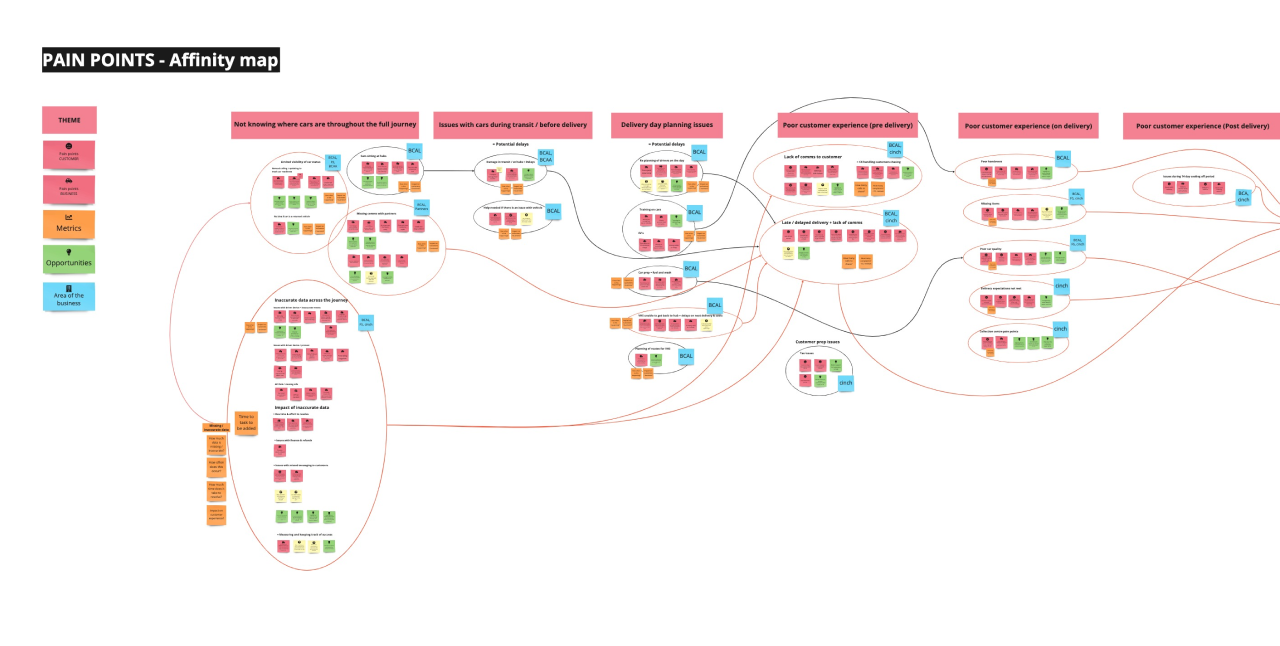
Affinity map of insights gained from the service blueprint
From the service blueprint, I had identified multiple areas of opportunity in order to drive a leading delivery experience for cinch customers. Key opportunities involved better alignment, communication and visibility of vehicles moving through the various business areas via better system integration, to ensure everyone is kept in the loop and updated if anything changes.
I also highlighted some more tactical opportunities, including setting clearer expectations of the delivery experience to customers through improved communication post ordering.
Prioritising problems to solve
Now I had provided a backlog of problems to solve, I worked with the product team to prioritise where to focus first. Using data, we looked at how much impact the problem had on customers and the business, how many customers it impacted and how much effort was involved.
The first problem we agreed to focus on was improve the visibility of vehicles on the day of delivery. This was an area that impacted all customers and was also costing the business in time and effort so we knew it would be extremely worthwhile to start here.
Playing back findings with stakeholders
Once I had built the service blueprint, conducted analysis and helped the team create a prioritised list of opportunities, I complied all our learnings ready to playback to stakeholders. In this session, we talked through all the problems across the service and how we aimed to address them collaboratively.
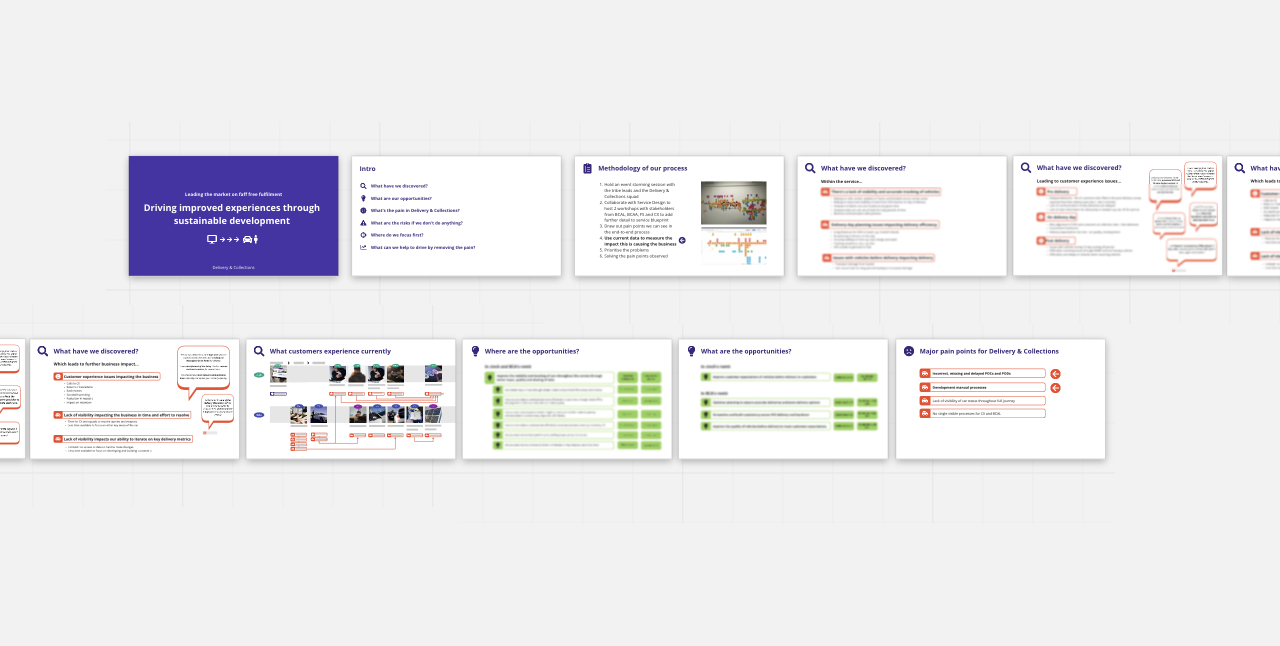
Presentation to stakeholders of learnings and opportunities
Design
Going back to the service blueprint I started to design a high level vision of what the improved service would look like. To do this, I started with looking at what an optimised customer journey could be. I then started to layer in service elements that would need to happen in order to deliver that to customers.
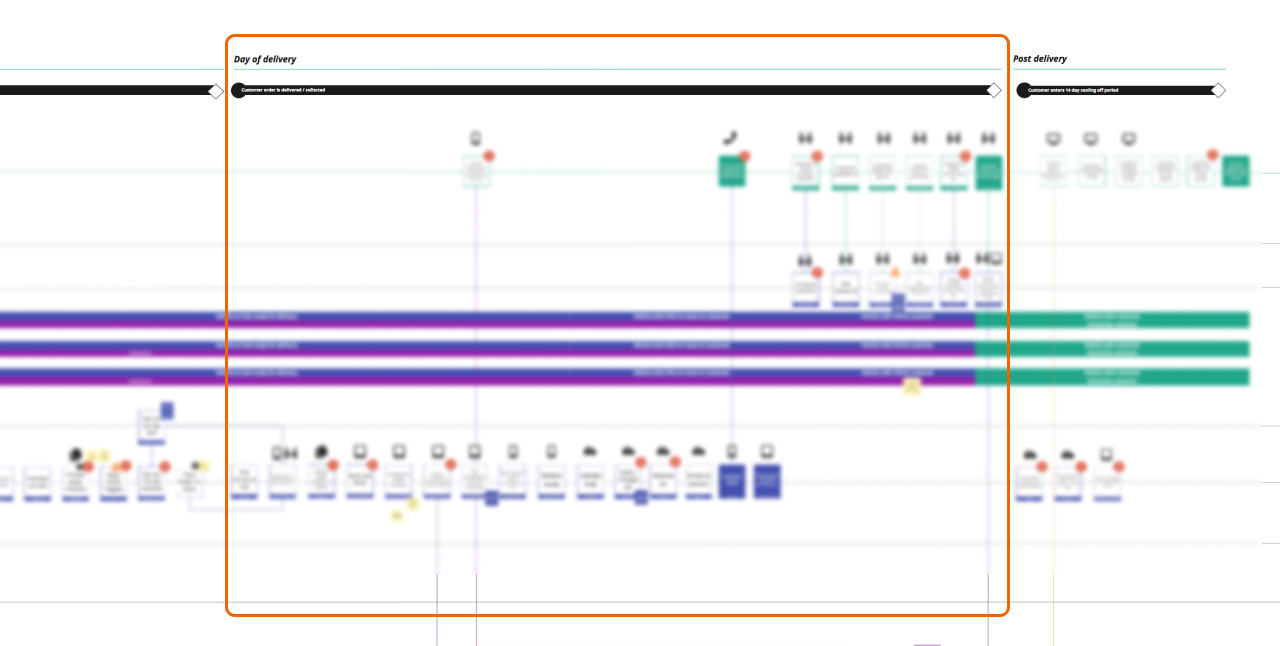
Highlighting sections of the service within the full end to end

High level vision of how the service could be delivered to customers
An example of this was to provide customers with an accurate estimated time of arrival of the delivery driver on the day of delivery which currently didn't exist. In order to do this, I designed a service that would allow delivery drivers to press a button within their delivery app that that would press when they were setting off. This would trigger an SMS and/or email to our customers in real time so they would know when to expect the arrival of their new car.
A bigger strategic piece to help gain more visibility and tracking of vehicles on the day of delivery was to improve both driver processes and the driver app. To start designing this part of the service, I needed to run more observational studies across various driver hubs across the country to understand more about driver behaviours and needs. Whilst this would be a longer term piece, I advised that we start to make iterations on the current driver app in order to deliver accurate estimated times of arrival for customers. Working with the product team, UX team and technical team, my job was to go back into the service blueprint to support the building of the new service features through ideation sessions and prototyping the concept.
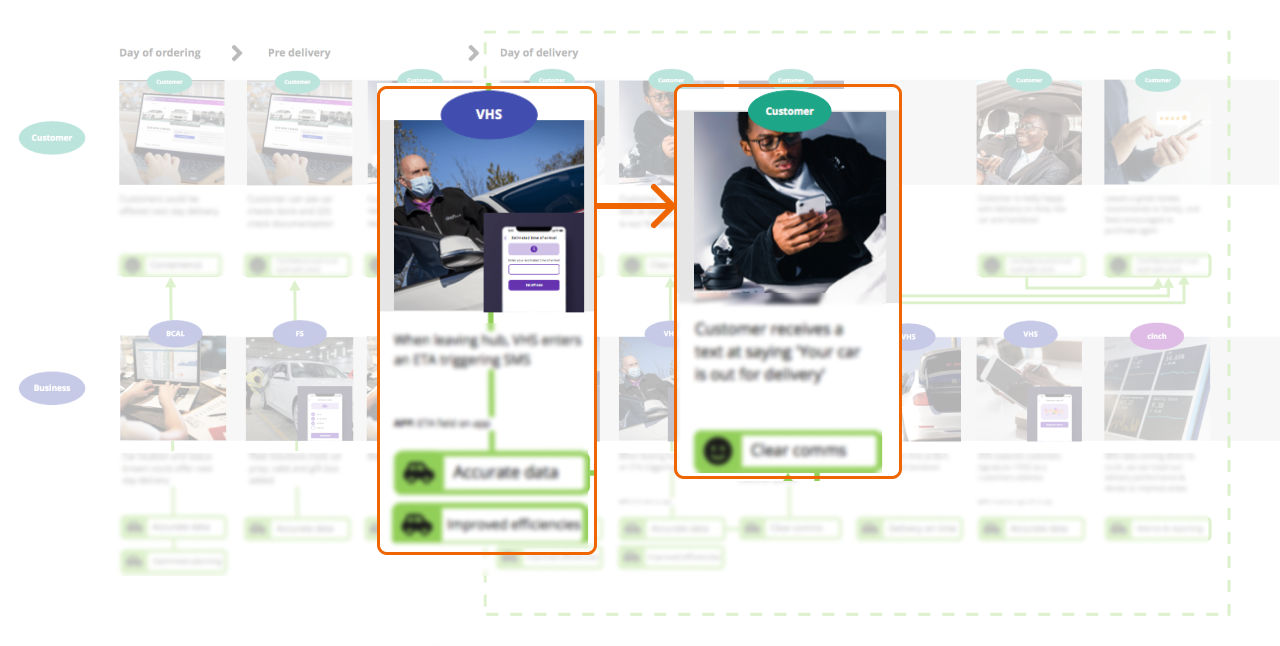
Designing an improved service to drive improved customer experiences
Outcomes
The main outcome of this work of creating a shared understanding of the service was achieved by developing the service blueprint collaboratively with all business areas. The service blueprint can be used continually by the business to keep iterating and building from. The shared understanding has also been beneficial to other business areas that sit outside cinch too. My analysis of the service, from the service blueprint has already driven the backlogs of multiple roadmaps across the business to deliver improvements for both customers and the business of cinch and the wider Constellation Group.
Feedback
"Great work on the fulfilment blueprint, cinch will be getting the benefit of this work for a long time" - cinch
"Loving the blueprint you have developed and awesome to be able to collaborate (and steal) ideas from it" - cinch
"Service fulfilment work was amazing for not just cinch, but Constellation Group as a whole. They were able to understand the bigger picture and the problems with the current delivery events due to her work" - cinch